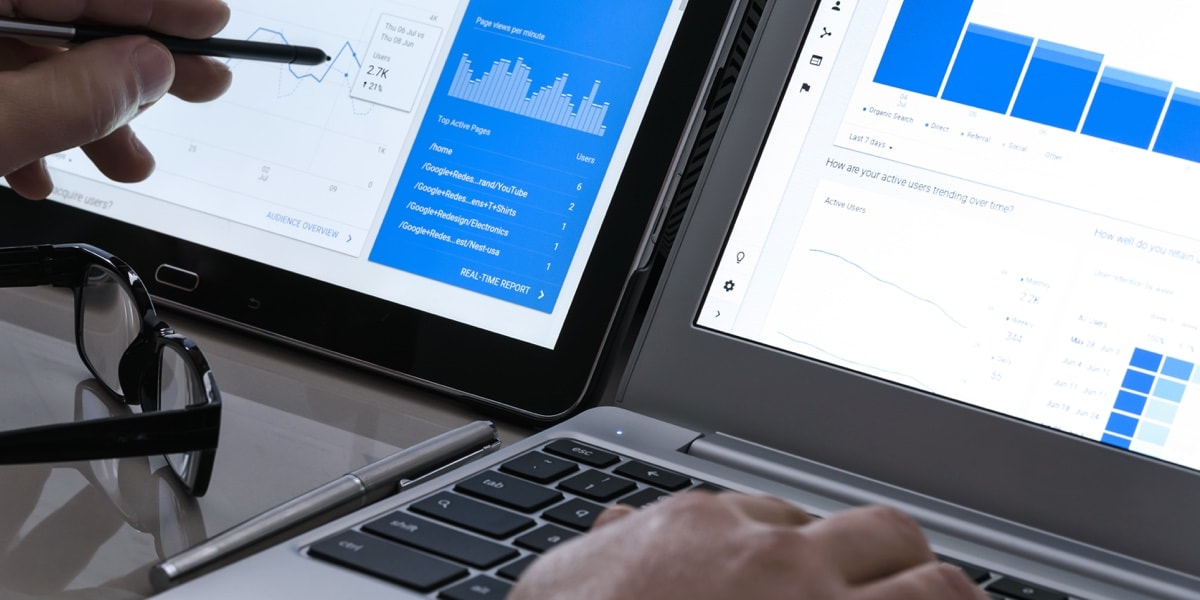Every field is ring-fenced by its own specialist vocabulary. Whether its the legalize of the lawyer or the acronym-heavy shorthand of the marketer, this terminology can serve as an intimidating barrier to entry for the budding career changer.
And the field of Data Analytics is no different. If you were a fly on a wall at a meeting of data analysts, you’d overhear them discussing doing all sorts of things to their data, from mining it, to mapping it, to modeling and monitoring it. You needn’t be intimidated, though. All these terms are simple enough to understand—and in this article, we’ll prove it.
By the end, you’ll have a basic understanding of the most essential processes, tools and tasks in Data Analytics. These are all covered in detail in our fully mentored Intro to Data Analytics Course, which takes you from complete beginner to data savvy in just one month. For now though, let’s crack open the top twenty-five terms and find out what’s inside.
1. Dashboard
Data analysts use a data visualization tool, commonly known as a dashboard, to convert all the data they receive into charts and graphs.
It’s essentially their control room, and they’ve probably spent many painstaking hours constructing this data hub. Make sure to tell them it looks great.
2. Data collection
A rather broad term to describe the actual act of collecting data. Data is collected via numerous methods, depending on the nature of the business or organization.
Data might be collected from the results of an online survey, or via sensors that record the comings and goings of people entering a shopping centre. A data analyst has to ensure that the data is collected securely and without encountering problems.
3. Statistics
Data analysts should have at least a rudimentary understanding of statistics, since they often play a part in the analyzing of data.
It’s important to know the difference between discrete variables and continuous ones, and data analysts will need to have a good grasp of statistical modelling. Start here: What’s the difference between descriptive and inferential statistics?
4. Data modelling
Data models are fairly difficult for the layman to get their head around. To put it simply, data models are used to map out the ways in which data needs to flow.
Using text and symbols, the relationships between complex streams of data and their movements can be understood at a more basic level. Once you establish where the data’s headed, you can begin to plot out how you plan to analyze it.
5. Data accuracy
Data accuracy, on the other hand, is a fairly simple concept. The data you gather and record must be correct, otherwise business decisions are going to be made based on false information.
Another aspect of data accuracy relates to the methods of data collection—there should be standard ways of collecting data within a business to ensure consistent data gathering.
6. Data mining
Data mining is at the heart of data analytics—broadly speaking, it refers to the whole process of searching through data to identify patterns and trends.
Data analysts operate at the coalface of the information industry.
7. Data monitoring
Data analysts are expected to routinely check the gathering and storage of data to ensure it meets standards of quality and formatting.
Good data monitoring practices will save a business time and money by avoiding having to check data before it is moved.
8. Data cleaning / data cleansing
Data cleaning is the act of removing data that will lead to distorted or inaccurate analysis.
If your data is dirty, either because you’ve collected it in a poor way, or because it contains inaccuracies, then it’s time to put on a wash – wrong decisions are going to be made down the line.
9. Predictive analysis
Also known as predictive modelling, predictive analysis involves using data to make assumptions and predictions on future outcomes.
It’s essential to use predictive analysis to maintain a competitive advantage in business.
10. Data integrity
Data integrity is the maintenance and protection of data over its entire lifecycle. It relates to security, backing up and removing duplicate data.
11. Data extraction
Data extraction is the actual process of taking data from its source with the intention of storing or processing it.
Usually the data is unstructured at the point of extraction, and can be in any form, such as tables and indexes.

12. Data validation
Data validation involves ensuring the data you gather is correct and meaningful. Data analysts need valid data, otherwise they’re nothing!
In Excel, the data validation tool involves placing rules on cells so that users inputting data are restricted with what they enter. This ensures users can’t make mistakes, and you don’t end up with invalid data.
13. Data transformation
It’s seldom the case that data extracted at the source is in the correct format for analysis. It needs to be converted to a format used by the destination system.
For example, when moving data to a cloud data warehouse, the data type typically needs to be changed.
14. Forecasting
Like predictive analysis, forecasting lies at the heart of data analysis. It’s about making decisions on the future based on past and present data.
A variety of methods are used in forecasting, and what you use depends on what kind of data you’re analyzing.
Qualitative forecasting methods are used when the data available isn’t relevant to the forecasts, whereas quantitative methods are used when handling numerical data.
15. Building a data pipeline
One of the most important aspects of data analysis is maintaining an efficient flow of data. Without enabling data to flow successfully, a data analyst can’t begin their work.
Many things can go wrong with the flow of data, and the data pipeline aims to make the route as smooth and direct as possible. It’s not without its flaws however, and data can become corrupted or become duplicated in transit.
16. Data integration
This involves unifying data from a variety of different sources.
For example, combining the databases of two companies that are merging, or when data needs to be shared with other parties.
As data becomes more and more significant in business, the process of data integration is becoming increasingly common.
17. Algorithms
Algorithms, which are step-by-step methods used to solve problems, are used throughout data analytics.
Having a good grasp of how to create algorithms in Excel is an essential part of the role of data analyst. They’re used to manipulate data, whether it be searching for a particular item, sorting items or locating certain aspects of data.
18. Mapping
Crucial to the success of many data processes, data mapping is an integral part of the larger processes of data migration and data integration.
Mapping matches fields from different data sources so that data can be moved successfully. What appears in one field, for example a telephone number, needs to be accurately replicated in the corresponding destination field.
19. Segments / segmentation
The process of segmentation involves separating and dividing up data into chunks, so that can focus on specific analysis of a certain aspect of the data.
Segmentation is essential to data analysis in marketing, so that you can focus on particular customer buying habits more closely.
20. Unstructured data
This is data that doesn’t fit in a conventional database, generally because by nature it is impossible to analyze.
More often than not, text is classified as unstructured data. Surveys, call centre transcripts and other such forms of data are examples of unstructured data.

21. APIs
Application Protocol Interfaces, ready-made code which automates a range of functions, are often used in data analysis. To speed up the process of predictive analysis, APIs are used to quickly crunch and digest data. We need to convert information into intelligence, and APIs makes data analysts lives easier by undertaking the often monotonous tasks associated with such work.
22. Data enrichment
When speaking about customer data, the process of data enrichment relates to the merging of third-party data with existing data.
The term “enrichment” relates to the fact that your raw data becomes much more valuable when you add extra data to it. It’s all to do with knowing more about your customers, and when equipped with such knowledge brands are able to personalise their marketing.
23. Data accessibility
By improving the accessibility of your data, other stakeholders are able to use such data to influence their own decisions. The more knowledge a company’s employees are about their data, the better equipped they are to make informed decisions, thus staying ahead of the competition.
24. Data reconciliation
Data reconciliation is essentially a check that is made to ensure a data migration is functioning correctly. The target data is compared against the original source data to check everything is going to plan. It’s important to demonstrate that the migration is not encountering problems.
25. Data standardization
In order to allow disparate sets of data to be used together, a common form has to be determined. It’s essentially the act of putting different variables on the same scale, so that they can be compared and contrasted. This process happens after the data is taken from the source and before it is loaded into the target systems.
So what do you think? All these terms and processes may seem daunting at first, but if any of them have piqued your interest, why not try this free introductory data analytics short course? Aside from this post, we’ve also covered the differences between data analysts and data scientists, while our data analyst salary guide will give you an idea of what you can earn as a data analyst.

